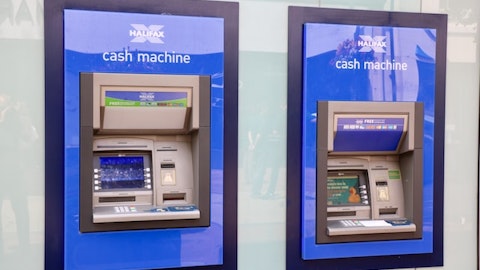The primary focus there is more individual bank deals. This is not a big effort for us.
Casey Whitman: Okay, appreciate it. Thank you for taking my questions. I’ll let someone else, and I’ll step back.
Bill Cimino: Thanks, Casey. And Josh, we’re ready for our next caller, please.
Operator: Thank you. One moment for our next question. Our next question comes from Catherine Mealor with KBW. You may proceed.
Bill Cimino: Hi, Catherine.
Catherine Mealor: Thanks, good morning. Hey, good morning. Seeing that you really a nice quarter. You saw some nice growth in service charges and trust fees. Just kind of curious how you’re thinking about fee growth into the next quarter and really how do you think you’re going into ’24?
John Asbury: Yes. So in terms of those categories, it really is being impacted by net client growth, the number of accounts. We see about 2% top 3% in new client growth. So we’d expect to be in the 2% to 3%, 2% to 4% growth rate as we go forward. Also included there is debit card interchange. So we continue to see more growth there as well, with the number of new accounts coming in as well. And then there’s seasonal impacts in the fourth quarter. So you’d expect to see some of that Q3 to Q4 increase with the holiday season and more transactions coming through. But in the end, we’re talking about 2% growth in those categories as we go forward on a standalone basis.
Catherine Mealor: Thanks. Great. And then on loans. John, you made a comment that you’re still in growth mode, going into the fourth quarter. How do you – how do you think about growth into next year and just where you’re comfortable adding new loans where you are kind of pulling back and really what this kind of client appetite is today with higher rates?
John Asbury: Yes. I’m going to add, We have Doug Woolley, Chief Credit Officer; and David Ring, Head of Commercial Banking here, too. And since most of the production comes out of the commercial side, I’ll ask Dave to comment. My few sense on this is that, the environment, it is opaque. I do think that, in general, our economy, as I indicated in my prepared comments is in good shape. We are in the budgeting process for next year. And at this point, what we are discussing would be something in the mid-single-digit loan growth range. I think we will continue to be able to grow at a medium pace. We’ll see what happens. Dave, as you think about it, what is your take on this?
David Ring: Yes, our pipeline going into the year would support that, John, in the mid-single-digit growth. It’s probably going to come more from the C&I and Equipment Finance and the regular businesses that operating businesses versus real estate. We just saw our production for this quarter be two-thirds C&I, and one-third real estate. So we’re seeing that start to happen today, and we think it’ll continue into the next quarter, into the next year.
John Asbury: I think that’s a good assessment. It really points back to the merit of our 7-year-long effort to diversify the bank’s capabilities. If we were just a commercial real estate lender, I would be giving you a different answer. But I think that diversification of the things that we do, the brand that we’ve built for small and mid-sized businesses, and the overall strength of our markets, all of this makes us bullish. The wild card will be American National Bank. I don’t want to get too far into that right now, but as we said when we announced the merger, we bring a bigger balance sheet. We bring infrastructure and capabilities, particularly on the C&I side. You marry that with the great team that they have, the reputation that they have, the physical presence, the things we can do and kind of the industrial markets of the South Side of Virginia, or Southern Virginia, as I should call it, and then the entry into Piedmont Triad, all of these things give us confidence that we should be able to achieve, let’s just call it mid-single-digit growth, and then we’ll see what happens from there.



